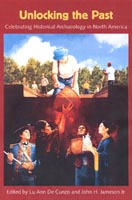Spaniards
and Native Americans at the Missions of La Florida
by Jerald T. Milanich

Researchers have undertaken a number of projects to learn about life at these missions. Across northern Florida and in southern and coastal Georgia, excavations have uncovered clues to the impact of colonialism on the native people. The evidence gathered so far is remarkable. Archaeologists have excavated entire churches burned in rebellions. We have even discovered small religious medallions associated with confradias (Catholic co-fraternities) and worn by Christian Indians to display their piety. Changes in foodways accompanied these changes in native beliefs. We have found numerous examples of those dietary changes, including chicken bones and grains of wheat, both introduced from Spain. We now understand the economic contributions made to the colonies by the mission Indians. These important contributions, reflected in things as innocuous as tiny charred corn cobs, tell a story of crops planted, harvested, shucked, ground into meal, and transported to St. Augustine at the behest of colonial officials and native chiefs, then exported to produce a profit. We have learned that the Spanish established more than 150 churches before 1763, most in Florida and Georgia. In that year, the politics of colonial expansion forced Spain to cede what was left of its La Florida colony to Great Britain.
We still have much to learn about the missions in north Florida, but together archaeological and archival research has provided important clues. We can now plot the pre- and post-rebellion missions and we have found many of them. At these and other missions throughout La Florida, we have uncovered not only the remains of buildings and meals and tokens of religious belief. We have also excavated with painstaking care the remains of the native peoples who lived and died there. Working with bioarchaeologists like Clark Larsen, we learn much about work, disease, diet, and death from the bones themselves. Together historical archaeology and bioarchaeology are powerful tools. They give voice to people of the past, including the Spanish friars and the Indians who together labored at the missions of Spanish Florida.
Jerland T. Milanich is curator in archaeology at the Florida Museum of Natural History.